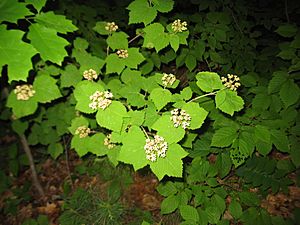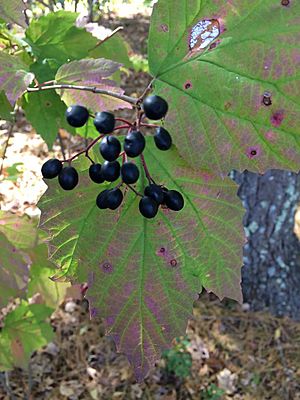Mapleleaf viburnum facts for kids
Quick facts for kids Mapleleaf viburnum |
|
|---|---|
 |
|
| Conservation status | |
| Scientific classification | |
| Genus: |
Viburnum
|
| Species: |
acerifolium
|
 |
|
| Natural range in North America | |
Viburnum acerifolium, also known as the mapleleaf viburnum, is a cool plant found in eastern North America. You can find it from southwestern Quebec and Ontario in Canada, all the way south to northern Florida and eastern Texas in the United States. This plant is tough and can grow in many different climates, from chilly areas to warmer ones.
Contents
What Does It Look Like?
The mapleleaf viburnum is a type of shrub, which is like a small, bushy tree. It usually grows about 1 to 2 meters (3 to 6 feet) tall.
Leaves and Colors
Its leaves grow in pairs, opposite each other on the stem. They are about 5 to 10 centimeters (2 to 4 inches) long and wide. The leaves have three to five parts, called lobes, and their edges are jagged, like tiny saw teeth. The surface of the leaves feels a bit fuzzy. In the fall, these leaves put on a beautiful show! They can turn many different colors, from pale yellow to bright yellow, orange, pink, or even a deep red-purple. The exact color depends on how much sunlight the plant gets and what the weather is like.
Flowers and Fruit
The flowers are small and white, with five tiny petals. They grow in clusters that look like flat-topped domes, about 4 to 8 centimeters (1.5 to 3 inches) wide. These flowers are great at attracting butterflies and birds! After the flowers bloom, they turn into small, round fruits called drupes. These fruits are red at first, then change to a dark purple-black color when they are ripe. They are about 4 to 8 millimeters (about 1/3 of an inch) long.
Where It Grows Best
This plant loves to grow in and around upland forests. It's super adaptable and can even grow well in full shade and dry soil. It prefers soil that is a bit acidic, with a pH between 5.0 and 6.5, but it can handle slightly less acidic soil too. The mapleleaf viburnum often sends out new shoots from its base, which means it can form a whole group of plants over time.
Where Can You Find It?
You can find Viburnum acerifolium in many US states. These include Connecticut, Maine, Massachusetts, New Hampshire, Rhode Island, New York, and Vermont in the Northeast. It also grows in states like Illinois, Wisconsin, Florida, Arkansas, and Texas.
Its Natural Home
This plant is often suggested by garden experts for places that are shady and dry. However, it's not super common in regular garden stores. You usually have to look for it at very large nurseries or special stores that sell native plants.
Ecology and Wildlife
The mapleleaf viburnum is very important for local wildlife.
Pollinators and Pests
Its white flowers produce lots of nectar and pollen. This attracts many different insects, including various types of bees, flies, beetles, wasps, and many kinds of butterflies (even skippers!). The plant is also a host for the caterpillars of the Celastrina ladon butterfly.
However, it can also attract some pests. For example, certain types of aphids and wood-boring beetle larvae are known to feed on it.
Food for Animals
The small, dark berries are a favorite snack for many animals. Skunks, rabbits, deer, eastern chipmunks, and different kinds of mice all love to eat them.
Why It's Called "Mapleleaf"
The scientific name acerifolium and its common name "mapleleaf viburnum" come from how much its leaves look like those of some maple trees. People sometimes mistake young mapleleaf viburnums for young maple trees. But it's easy to tell them apart by their flowers and fruit. The viburnum makes small, purple berries, while maple trees produce dry, winged seeds that spin like helicopters when they fall.
Uses
The red berries of the mapleleaf viburnum appear from late summer into autumn. These berries can be picked and made into tasty jam!
See also
 In Spanish: Viburnum acerifolium para niños
In Spanish: Viburnum acerifolium para niños



